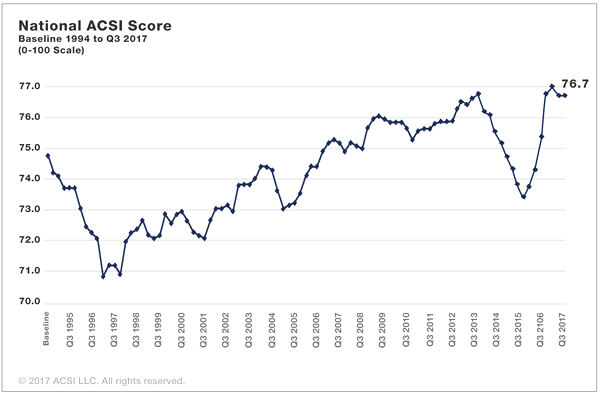
We’ve had it drilled into our heads for years: the importance of a more customer-centric business model. How embodying customer-centricity within an organization to help ensure business relevance (and resonance) in a commercial relationship most will agree is now firmly weighted in favor of the customer.
We’re constantly reminded of the customer-centric champions. Companies such as Amazon or Zappos who put the customer at the center of everything they do, even at the expense of growth goals. These businesses are willing to take big gambles in order to deliver outstanding customer satisfaction, convenience, value – and loyalty.
OK, so we’re all aware of the customer-focused corporate superstars. But what about the rest of us? How are ‘normal’ businesses implementing customer-centricity in their day-to-day interactions?
The answer, overwhelmingly, seems to be not that well – if at all.
Is True Customer-Centricity An Impossible Dream?
Take a look at this graph, recently published by The American Customer Satisfaction Index:

It shows that, in the USA at least, “…customer satisfaction is steady at an ACSI score of 76.7 (on a 0-100 scale) following recent periods of both sustained decline and improvement.”
But take another look at that graph. It also shows that, from 1994 to Q3 2017, the overall change in customer satisfaction has grown from just under 75 to 76.7. An increase of perhaps 2 clicks over the course of twenty-three years.
Clearly, even if we all know what we’re supposed to be doing, few businesses are actually doing anything that moves the needle.
So is true customer-centricity in business an unattainable position? Have we been sold a dud?
Improving Customer Experience In Other Ways
I think part of the issue is actually defining what ‘customer-centricity’ actually means. It’s rather an abstract term, don’t you think? Sure, you can take it to mean ‘putting the customer first.’ But how does that actually physically manifest itself in a real-world use case?
Perhaps the difficulty in expressing what a customer-centric business might look like in practice is part of the problem. The definition of the term open to interpretation which, as a consequence, means it looks different depending on who you ask. In which case it’s no surprise that so few organizations have made a success of implementing it. Without a clear and universally-agreed definition, how can any business really hope to employ it?
In order to hit the target, all of us first have to agree what the target looks like.
Departmental Disconnect
The most ardent fans for implementing a more customer-centric organization are often found within departments that are, by definition, more customer-facing. The C-Suite, marketing, sales, and support are always going to be the biggest flag-wavers.
That’s all well and good. But the bigger issue is how non customer-facing personnel see things. If you’re not careful, they could be left with the feeling their department is seen by those up top as being ‘less important’.
Then there’s the challenge of how to implement customer-centricity in business areas that, often by their nature, are there for the organization more than the clientele. Take the accounts department, for example. If customer-centricity is meant to be an organization-wide initiative, how are the accounts people meant to deal with a customer who hasn’t paid their bill?
What Gets Measured Gets Done
There are plenty of ways to measure customer satisfaction, but how you do measure the level of customer-centricity within a business?
Customer satisfaction is feedback on someone’s perception on what they received, or how well they were treated. But if customer-centricity is a measure of how effectively a business puts the customer at the epicenter of what they do, how do you quantify that?
Improving customer experience is a result – a goal. Since it can be measured, it’s easier to slap a target on its back. You could say that you wanted to improve customer satisfaction ratings from 75% to 85% within 12 months, for example.
Customer-centricity, on the other hand, is an ongoing process. It’s not the end-goal, but rather a means in getting to that goal.
Moreover, do all initiatives ostensibly described as being customer-centric result in an improved customer experience? I’d say most definitely not. Perhaps the lack of a true definition and measurement metric is part of the problem.
Want an example? How about targeted and/or programmatic advertising? How many of us as consumers enjoy being served an ad that seems to follow us wherever we go online? The continued proliferation and growth of browser ad blockers (up 30% in the past year) as well as directives such as GDPR, would suggest that most of us don’t see such stalking tactics as ‘adding to the customer experience.’ Far from it.
Just because you can, doesn’t mean you should.
So are businesses using the excuse of customer-centricity to implement scummy interruptive tactics like spam email and SMS texting, beacons, programmatic, and the rest? How customer-centric is a corporate chest-beating tweet, Facebook update, or email pushing an organization’s offer du jour?
Perhaps, as with most approaches, the reason why customer-centricity isn’t more prevalent in the real world is due to lazy, ineffective (and downright insulting) abuse of the term to allow nefarious organizations to get away with murder.
Have We Been Looking At Customer-Centricity All Wrong?
Perhaps we’ve been looking at this too simplistically.
We’ve been focusing on how to align internal and external practices and deliverables around the customer, we’ve been missing another powerful driver in all of this. Rather than being customer-centric, maybe we should be employee-centric.
There’s plenty of supporting evidence showing the correlation between employee satisfaction and customer satisfaction. You can’t sell it outside, until you sell it inside.
But what if we take a step back even further?
Couldn’t it be argued that every stakeholder within an organization should be valued and considered from a strategic position? Directors, creditors, suppliers, partners, unions, distributors – don’t they all have the ability to shape the customer experience to varying degrees? Sure, you’re not going to get very far without having customers. But how far are you going to get with low-quality raw materials from your suppliers, or from staff who feel disenfranchized and under-valued?
A “Customer-Centric Business” Has Multiple Meanings
Supposing we can agree that, in its current guise, the concept of customer-centricity is too nebulous, abstract, and undeterminable. Where should forward-thinking organizations be focussing their attention instead?
I think the answer probably lies somewhere in between the ultimate goal of customer-centricity, as well as other noble pursuits such as a more open and social business model. That end point being the creation of tangible value for customers in such a way that it necessarily produces tangible value for the organization.
Blowing our own trumpet
Many thanks to the team at Feedspot for selecting us as one of the Top 40 Small Business Marketing Blogs on the web, as well as one of the top 100 UK marketing blogs for marketers.It’s really appreciated.
Recent articles:
Dark Social: The Hidden Conversations Marketers Can’t See

Marketing In A Recession: How To Weather The Storm

How To Convince A Marketing Skeptic

Privacy Protection: Why Ad Tracking Must End

Marketing Isn’t About Being Brave: It’s About Being Effective

Why Seeking Consensus Prevents Business Innovation



